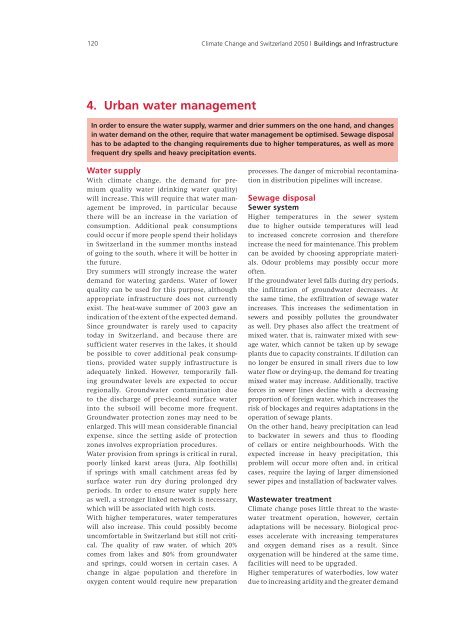Climate Change and Switzerland 2050 - OcCC - SCNAT
Climate Change and Switzerland 2050 - OcCC - SCNAT
Climate Change and Switzerland 2050 - OcCC - SCNAT
You also want an ePaper? Increase the reach of your titles
YUMPU automatically turns print PDFs into web optimized ePapers that Google loves.
120 <strong>Climate</strong> <strong>Change</strong> <strong>and</strong> Switzerl<strong>and</strong> <strong>2050</strong> | Buildings <strong>and</strong> Infrastructure<br />
4. Urban water management<br />
In order to ensure the water supply, warmer <strong>and</strong> drier summers on the one h<strong>and</strong>, <strong>and</strong> changes<br />
in water dem<strong>and</strong> on the other, require that water management be optimised. Sewage disposal<br />
has to be adapted to the changing requirements due to higher temperatures, as well as more<br />
frequent dry spells <strong>and</strong> heavy precipitation events.<br />
Water supply<br />
With climate change, the dem<strong>and</strong> for premium<br />
quality water (drinking water quality)<br />
will increase. This will require that water management<br />
be improved, in particular because<br />
there will be an increase in the variation of<br />
consumption. Additional peak consumptions<br />
could occur if more people spend their holidays<br />
in Switzerl<strong>and</strong> in the summer months instead<br />
of going to the south, where it will be hotter in<br />
the future.<br />
Dry summers will strongly increase the water<br />
dem<strong>and</strong> for watering gardens. Water of lower<br />
quality can be used for this purpose, although<br />
appropriate infrastructure does not currently<br />
exist. The heat-wave summer of 2003 gave an<br />
indication of the extent of the expected dem<strong>and</strong>.<br />
Since groundwater is rarely used to capacity<br />
today in Switzerl<strong>and</strong>, <strong>and</strong> because there are<br />
sufficient water reserves in the lakes, it should<br />
be possible to cover additional peak consumptions,<br />
provided water supply infrastructure is<br />
adequately linked. However, temporarily falling<br />
groundwater levels are expected to occur<br />
regionally. Groundwater contamination due<br />
to the discharge of pre-cleaned surface water<br />
into the subsoil will become more frequent.<br />
Groundwater protection zones may need to be<br />
enlarged. This will mean considerable financial<br />
expense, since the setting aside of protection<br />
zones involves expropriation procedures.<br />
Water provision from springs is critical in rural,<br />
poorly linked karst areas (Jura, Alp foothills)<br />
if springs with small catchment areas fed by<br />
surface water run dry during prolonged dry<br />
periods. In order to ensure water supply here<br />
as well, a stronger linked network is necessary,<br />
which will be associated with high costs.<br />
With higher temperatures, water temperatures<br />
will also increase. This could possibly become<br />
uncomfortable in Switzerl<strong>and</strong> but still not critical.<br />
The quality of raw water, of which 20%<br />
comes from lakes <strong>and</strong> 80% from groundwater<br />
<strong>and</strong> springs, could worsen in certain cases. A<br />
change in algae population <strong>and</strong> therefore in<br />
oxygen content would require new preparation<br />
processes. The danger of microbial recontamination<br />
in distribution pipelines will increase.<br />
Sewage disposal<br />
Sewer system<br />
Higher temperatures in the sewer system<br />
due to higher outside temperatures will lead<br />
to increased concrete corrosion <strong>and</strong> therefore<br />
increase the need for maintenance. This problem<br />
can be avoided by choosing appropriate materials.<br />
Odour problems may possibly occur more<br />
often.<br />
If the groundwater level falls during dry periods,<br />
the infiltration of groundwater decreases. At<br />
the same time, the exfiltration of sewage water<br />
increases. This increases the sedimentation in<br />
sewers <strong>and</strong> possibly pollutes the groundwater<br />
as well. Dry phases also affect the treatment of<br />
mixed water, that is, rainwater mixed with sewage<br />
water, which cannot be taken up by sewage<br />
plants due to capacity constraints. If dilution can<br />
no longer be ensured in small rivers due to low<br />
water flow or drying-up, the dem<strong>and</strong> for treating<br />
mixed water may increase. Additionally, tractive<br />
forces in sewer lines decline with a decreasing<br />
proportion of foreign water, which increases the<br />
risk of blockages <strong>and</strong> requires adaptations in the<br />
operation of sewage plants.<br />
On the other h<strong>and</strong>, heavy precipitation can lead<br />
to backwater in sewers <strong>and</strong> thus to flooding<br />
of cellars or entire neighbourhoods. With the<br />
expected increase in heavy precipitation, this<br />
problem will occur more often <strong>and</strong>, in critical<br />
cases, require the laying of larger dimensioned<br />
sewer pipes <strong>and</strong> installation of backwater valves.<br />
Wastewater treatment<br />
<strong>Climate</strong> change poses little threat to the wastewater<br />
treatment operation, however, certain<br />
adaptations will be necessary. Biological processes<br />
accelerate with increasing temperatures<br />
<strong>and</strong> oxygen dem<strong>and</strong> rises as a result. Since<br />
oxygenation will be hindered at the same time,<br />
facilities will need to be upgraded.<br />
Higher temperatures of waterbodies, low water<br />
due to increasing aridity <strong>and</strong> the greater dem<strong>and</strong>

















